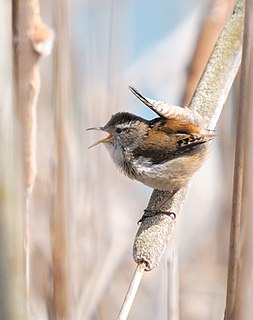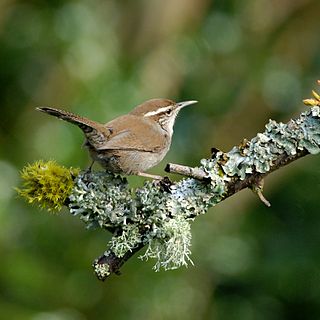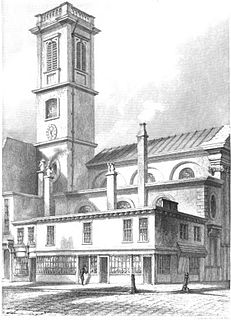Related Research Articles

Sir Christopher Wren PRS FRS was one of the most highly acclaimed English architects in history,as well as an anatomist,astronomer,geometer,and mathematician-physicist. He was accorded responsibility for rebuilding 52 churches in the City of London after the Great Fire in 1666,including what is regarded as his masterpiece,St Paul's Cathedral,on Ludgate Hill,completed in 1710.

St Paul's Cathedral is an Anglican cathedral in London. As the seat of the Bishop of London,the cathedral serves as the mother church of the Diocese of London. It is on Ludgate Hill at the highest point of the City of London and is a Grade I listed building. Its dedication to Paul the Apostle dates back to the original church on this site,founded in AD 604. The present structure,dating from the late 17th century,was designed in the English Baroque style by Sir Christopher Wren. Its construction,completed in Wren's lifetime,was part of a major rebuilding programme in the city after the Great Fire of London. The earlier Gothic cathedral,largely destroyed in the Great Fire,was a central focus for medieval and early modern London,including Paul's walk and St Paul's Churchyard,being the site of St Paul's Cross.

Wrens are a family of brown passerine birds in the predominantly New World family Troglodytidae. The family includes 88 species divided into 19 genera. Only the Eurasian wren occurs in the Old World,where,in Anglophone regions,it is commonly known simply as the "wren",as it is the originator of the name. The name wren has been applied to other,unrelated birds,particularly the New Zealand wrens (Acanthisittidae) and the Australian wrens (Maluridae).

The Monument to the Great Fire of London,more commonly known simply as the Monument,is a fluted Doric column in London,England,situated near the northern end of London Bridge. Commemorating the Great Fire of London,it stands at the junction of Monument Street and Fish Street Hill,202 feet (62 m) in height and 202 feet west of the spot in Pudding Lane where the Great Fire started on 2 September 1666. Constructed between 1671 and 1677,it was built on the site of St Margaret,New Fish Street,the first church to be destroyed by the Great Fire. It is Grade I-listed and is a scheduled monument. Another monument,the Golden Boy of Pye Corner,marks the point near Smithfield where the fire was stopped.

The marsh wren is a small North American songbird of the wren family. It is sometimes called the long-billed marsh wren to distinguish it from the sedge wren,also known as the short-billed marsh wren.

The house wren is a very small songbird of the wren family,Troglodytidae. It occurs from Canada to southernmost South America,and is thus the most widely distributed native bird in the Americas. It occurs in most suburban areas in its range and it is the single most common wren. Its taxonomy is highly complex and some subspecies groups are often considered separate species. The name troglodytes means "hole dweller",and is a reference to bird's tendency to disappear into crevices when hunting insects or to seek shelter.

The rock wren is a small songbird of the wren family native to South America and western North America. It is the only species in the genus Salpinctes.

The superb fairywren is a passerine bird in the Australasian wren family,Maluridae,and is common and familiar across south-eastern Australia. It is a sedentary and territorial species,also exhibiting a high degree of sexual dimorphism;the male in breeding plumage has a striking bright blue forehead,ear coverts,mantle,and tail,with a black mask and black or dark blue throat. Non-breeding males,females and juveniles are predominantly grey-brown in colour;this gave the early impression that males were polygamous,as all dull-coloured birds were taken for females. Six subspecies groups are recognized:three larger and darker forms from Tasmania,Flinders and King Island respectively,and three smaller and paler forms from mainland Australia and Kangaroo Island.

The Carolina wren is a common species of wren that is a resident in the eastern half of the United States of America,the extreme south of Ontario,Canada,and the extreme northeast of Mexico. Severe winters restrict the northern limits of their range while favorable weather conditions lead to a northward extension of their breeding range. Their preferred habitat is in dense cover in forest,farm edges and suburban areas. This wren is the state bird of South Carolina.

The Wren 460 is a STOL conversion of a Cessna 180 or 182 airframe.

The Bewick's wren is a wren native to North America. At about 14 cm (5.5 in) long,it is grey-brown above,white below,with a long white eyebrow. While similar in appearance to the Carolina wren,it has a long tail that is tipped in white. The song is loud and melodious,much like the song of other wrens. It lives in thickets,brush piles and hedgerows,open woodlands and scrubby areas,often near streams. It eats insects and spiders,which it gleans from vegetation or finds on the ground.

The Wren Building is the signature building of the College of William &Mary in Williamsburg,Virginia. Along with the Brafferton and President's House,these buildings form the College's Ancient Campus. With a construction history dating to 1695,it is the oldest academic building in continuous use in the United States. It was designated a National Historic Landmark in 1960.

Matthew Wren was an influential English clergyman,bishop and scholar.

The New Zealand rock wren is a small New Zealand wren endemic to the South Island of New Zealand. Its Māori names include pīwauwau,mātuitui,and tuke. Outside New Zealand it is sometimes known as the rockwren or South Island wren to distinguish it from the unrelated rock wren of North America.

The red-backed fairywren is a species of passerine bird in the Australasian wren family,Maluridae. It is endemic to Australia and can be found near rivers and coastal areas along the northern and eastern coastlines from the Kimberley in the northwest to the Hunter Region in New South Wales. The male adopts a striking breeding plumage,with a black head,upperparts and tail,and a brightly coloured red back and brown wings. The female has brownish upperparts and paler underparts. The male in eclipse plumage and the juvenile resemble the female. Some males remain in non-breeding plumage while breeding. Two subspecies are recognised;the nominate M. m.melanocephalus of eastern Australia has a longer tail and orange back,and the short-tailed M. m. cruentatus from northern Australia has a redder back.

The mallee emu-wren is a species of bird in the Australasian wren family,Maluridae. It is endemic to Australia.

St Dionis Backchurch was a parish church in the Langbourn ward of the City of London. Of medieval origin,it was rebuilt after the Great Fire of London to the designs of Christopher Wren and demolished in 1878.

Joel Chandler Harris House,also known as The Wren's Nest or Snap Bean Farm,is a Queen Anne style house at 1050 Ralph D. Abernathy Blvd.,SW. in Atlanta,Georgia. Built in 1870,it was home to Joel Chandler Harris,editor of the Atlanta Constitution and author of the Uncle Remus Tales,from 1881 until his death in 1908.

The cactus wren is a species of wren endemic to the deserts of the southwestern United States and northern and central Mexico. It is the state bird of Arizona,and the largest wren in the United States. Its plumage is brown,with black and white spots as markings. It has a distinctive white eyebrow that sweeps to the nape of the neck. The chest is white,whereas the underparts are cinnamon-buff colored. Both sexes appear similar. The tail,as well as flight feathers,are barred in black and white. Their song is a loud raspy chirrup;akin in the description of some ornithologists to the sound of a car engine that will not start. It is well-adapted to its native desert environment,and the birds can meet their water needs from their diet which consists chiefly of insects,but also of some plant matter. The cactus wren is a poor flier and generally forages for food on the ground. Ornithologists generally recognize seven subspecies,with the exact taxonomy under dispute.

The Eurasian wren is a very small insectivorous bird,and the only member of the wren family Troglodytidae found in Eurasia and Africa (Maghreb). In Anglophone Europe,it is commonly known simply as the wren. It has a very short tail which is often held erect,a short neck and a relative long thin bill. It is russet brown above,paler buff-brown below and has a cream buff supercilium. The sexes are alike.
References
- 1 2 "Tim Wren". ESPN Cricinfo. Retrieved 5 April 2014.
- ↑ Ellis C, Pennell M (2010) Trophies and Tribulations, p.204. London: Greenwich Publishing. ISBN 978-0-9564081-0-5.
- ↑ "From Phil Harding". Old Harveians Association. 17 February 2015. Retrieved 16 January 2021.
{{cite web}}: CS1 maint: url-status (link)